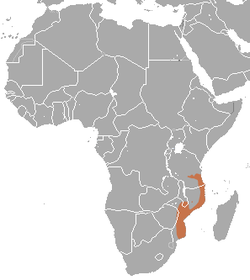| Paragalago | |
|---|---|
 | |
| Juvenile Grant's bushbaby (P. granti) | |
| Scientific classification | |
| Kingdom: | Animalia |
| Phylum: | Chordata |
| Class: | Mammalia |
| Order: | Primates |
| Suborder: | Strepsirrhini |
| Family: | Galagidae |
| Genus: | Paragalago Masters et al., 2017 |
| Type species | |
| Galago zanzibaricus Matschie, 1893 | |
| Species | |
Paragalago cocos Contents | |
The eastern dwarf galagos are a group of five species of strepsirrhine primates of the family Galagidae, native to East Africa. [1] They were formerly classified in the genus Galagoides but have been moved to their own genus, Paragalago, based on genetic evidence, and supported by differences in vocalizations and morphology. [2] The three western/Congolian species remain in Galagoides.
The two genera are not sister taxa and thus apparently evolved their small sizes and some morphological similarities via parallel evolution, although members of the eastern group tend to be larger. They are separated by the East African Rift. Paragalago is actually sister to the genus of 'lesser galagos', Galago , which are similar in size. [2] There is limited sympatry between Paragalago and the much more widely distributed Galago. Paragalago members range in mass from 60 to 250 g (2.1 to 8.8 oz), considered small to medium-sized among galagids. [2]
All five species have been evaluated by the IUCN. P. orinus is considered to be vulnerable, P. rondoensis to be endangered, P. zanzibaricus is listed as near threatened, while P. cocos and P. granti are of least concern.
The Taita mountain dwarf galago, found in the Taita Hills, is unclassified. [3] Based on vocalizations, it may be the Kenya coast galago. These dwarf galagos are present in very small forest fragments and are in immediate danger of extinction.







